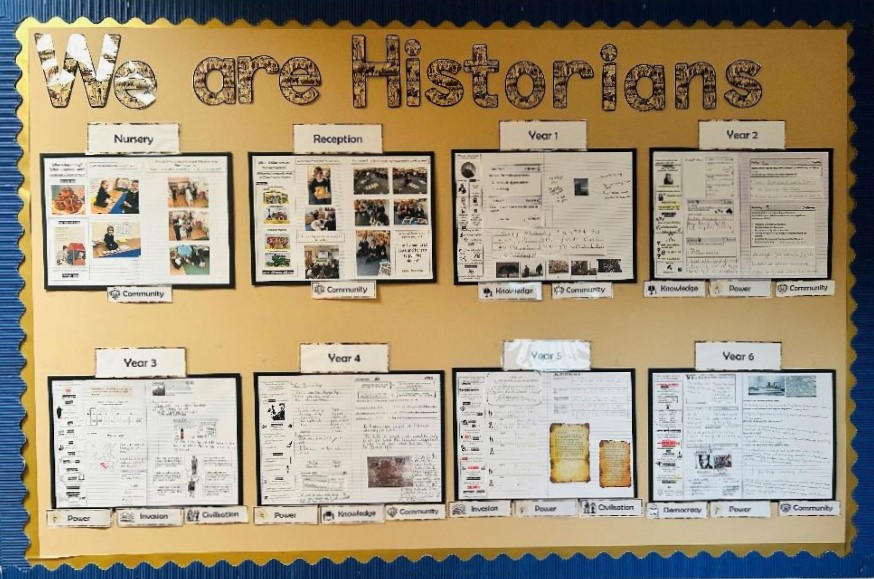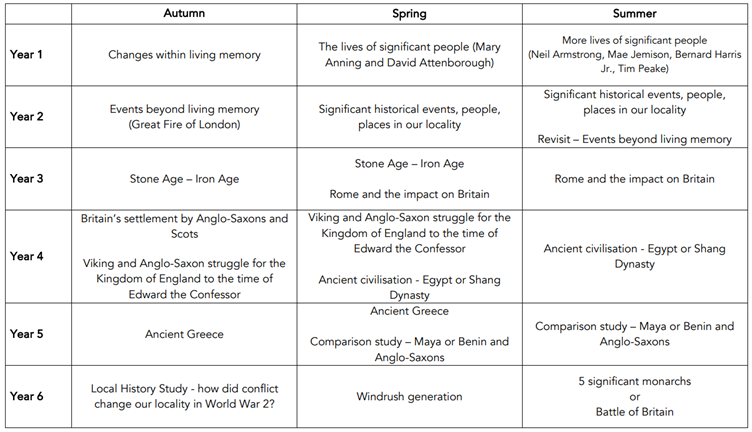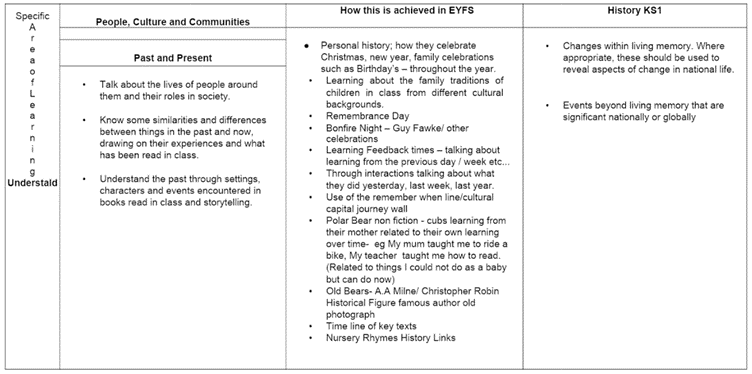History
At Croxby Primary School we are Historians!

Intent
Our aim is that, through the teaching of History, we stimulate all children’s interest and understanding about the life of people who lived in the past. We teach children a sense of chronology, in order to develop a sense of identity and a cultural understanding based on their historical heritage. This enables our children to learn to value their own and other people’s cultures in modern multicultural Britain.
We aim to make all children aware of the actions of important people in history and enable children to know about significant events in British history, whilst appreciating how things have changed over times. History will also ensure our children understand how Britain developed as a society, contributing to their understanding of their country of residence. Furthermore, our children will learn about aspects of local, British and Ancient history. This wider awareness leads to children having some knowledge of historical development in the wider world.
We believe that by allowing children to understand the importance and enjoyment of History through different opportunities, they will become enthused learners in History and informed for the future. In History at our school, we will also give children opportunities to develop their skills of enquiry, investigation, analysis, interpretation, evaluation and presentation.
There are two key aspects to learning:
Substantive knowledge - this is the subject knowledge and vocabulary used about the past. At Croxby, we focus on six substantive concepts that are threaded through the history curriculum and understanding deepened over time. These are defined at the start of every study in the Big Idea.
![]()
Disciplinary knowledge – this is the use of that knowledge and how children construct understanding through historical claims, arguments and accounts. We call it ‘Working Historically.’ The features of thinking historically may involve significance, evidence, continuity and change, cause and consequence, historical perspective and contextual interpretation.
Historical analysis is developed through selecting, organising and integrating knowledge through reasoning and inference making in response to our structured questions and challenges. We call this ‘Thinking historically’.
Substantive concepts, such as invasion and civilisation, are taught through explicit vocabulary instruction as well as through the direct content and context of the study.
Implementation
CUSP History is built around the principles of cumulative knowledge The effect of this cumulative model supports opportunities for children to associate and connect with significant periods of time, people, places and events.

*Knowledge notes are an elaboration in the core knowledge found in knowledge organisers. Knowledge notes focus pupils’ working memory to the key question that will be asked at the end of the lesson. It reduces cognitive load and avoids the split-attention effect.
* Retrieval practise is planned into the curriculum through spaced learning and interleaving and as part of considered task design by the class teacher. Teaching and learning resources and provided for class teachers so they can focus their time on subject knowledge and task design.
*Explicit Vocabulary is purposefully sequenced into the CUSP curriculum to ensure Tier 2 and 3 vocabulary are explicitly taught along with the etymology and morphology, relevant idioms and colloquialisms to ensure learning sticks. We aim to provide a high challenge with low threat culture and put no ceiling on any child’s learning, instead providing the right scaffolding for each child for them to achieve.
*Misconceptions are explicitly revealed as non-examples and positioned against known and accurate content as pupils become more expert in their understanding. Misconceptions are challenged carefully and in the context of the substantive and disciplinary knowledge. In CUSP History, it is recommended that misconceptions are not introduced too early, as pupils need to construct a mental model in which to position new knowledge.
* Cumulative quiz questions - Feedback, low-threat quizzes, thinking hard tasks and structured assessment tasks all contribute towards the bigger picture of how well pupils retain and remember the content.
Impact
The impact of this curriculum design will lead to outstanding progress over time across key stages relative to a child’s individual starting point and their progression of skills.
HOW DO WE KNOW WHAT CHILDREN HAVE LEARNED?
- Questioning
- Pupil Study (talking about learning with the children)
- Talking to teachers
- Low stakes ‘Drop-in’ observations
- Quizzing and retrieval practise
- Live feedback
Children will therefore be expected to leave Croxby reaching at least age-related expectations for History. Our History curriculum will also lead pupils to be enthusiastic history learners.
What is my child learning?
What is my child learning in their year group?
Here is the History long-term overview.
- Please note that to accommodate the effective implementation of CUSP curriculum this overview may vary for year 23/24 to ensure children have not duplicated topics from our previous curriculum.

EYFS
The Early Years Foundation Stage Curriculum supports children’s understanding of history through the planning and teaching of ‘Understanding the World’. We work in the area of ‘past and present’ where we explore chronology by looking at changes within living memory and when learning about significant people/events locally. This aspect is about how children find out about past and present events in their own lives, their families and other people they know.
Children are encouraged to develop a sense of change over time and are given opportunities to differentiate between past and present by observing routines throughout the day, growing plants, observing the passing of seasons and time and looking at photographs of their life and of others. We support our history learning through understanding the past through stories.
Our skilled early years practitioners encourage investigative behaviour and raise questions such as, ‘What do you think?', ‘Tell me more about?', 'What will happen if..?', ‘What else could we try?', ‘What could it be used for?', ‘How is this picture different from what you know/are used to?’, ‘How might it work?' and ‘Look at this photo of… what is the same and what is different?’ Use of language relating to time is used in daily routines and conversations with children for example, ‘time’, ‘week’, ‘month’, ‘year’, ‘later’, ‘yesterday', ‘old', ‘past', ‘now' and ‘then'. We ensure we are preparing our young historians by equipping them with the necessary skills to be successful in their future history learning by developing the disciplinary skills at an early stage.

KEY STAGE 1
Our focus is on young children developing a sense of time, place and change. It begins with children studying Changes within living memory to develop an understanding of difference over time within concrete experiences of their lives. This chronological knowledge is foundational to the understanding of change over time.
Pupils then study the Lives of significant individuals. Chronology and place in time steers the understanding of the context in which these significant individuals lived. Terms such as legacy are introduced and used within the context of each study.
In KS1, pupils study our local history through significant events, people and places.
Events beyond their living memory. Here, pupils draw upon early concepts of chronology and connect it to more abstract, but known, events in the past focusing on the Great Fire of London.
Note that we have a mixed 1/2 class and a mixed 3/4 class. These classes run a rolling programme.

LOWER KEY STAGE 2
In lower KS2, pupils study the cultural and technological advances made by our ancestors as well as understanding how historians think Britain changed throughout the Stone, Bronze and Iron Ages. Archaeological history guides us to know how early humans were creative, innovative and expert at surviving in changeable environments. Having an in-depth understanding of Iron Age Britain offers solid foundations for the study of how Rome influenced Britain.
Studies of how Britain was settled by Anglo-Saxons and Scots gives a focus on cultural change and the influence of Christianity. Pupils study how powerful kings, and their beliefs shaped the Heptarchy of Anglo-Saxon Britain
CUSP also focuses on the Struggle for throne of England through a study of the Vikings, their origins, conquests and agreements with English Anglo-Saxon kings to settle and dwell in the region known as Danelaw.
Note that we have a mixed 1/2 class and a mixed 3/4 class. These classes run a rolling programme.

UPPER KEY STAGE 2
Later in KS2, knowledge of Anglo-Saxons is revisited and used to connect with a study of the Maya civilisation. The study compares advancement of the Maya culture and innovation to that of the Anglo-Saxons around c.AD 900.
Pupils also study Significant monarchs after 1066. Five kings and queens are a focus of a depth study and comparison, drawing on their beliefs, actions and understanding their legacy.
Ancient Egyptians and the study of Ancient Greek life and achievements are also studied learning about their influence on the western world. The understanding of culture, people and places are central to these studies. CUSP History connects these studies with prior knowledge of what was happening in Britain at the same time.
Recent history, such as the Battle of Britain for example, is studied in the context of how conflict changed society in the Second World War. Modern history is also studied through units such as the Windrush Generation. Knowing about slavery, Caribbean culture and the injustice of the past enlightens pupils to understand why events happened and how these pioneers' faced racism, discrimination and prejudice.

